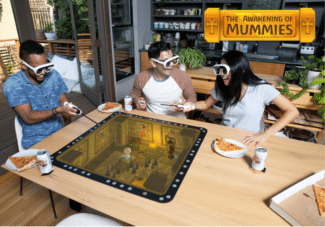Jeri Ellsworth sees Tilt Five paving the path to mainstream AR.
Tech giants like Apple, Google, Microsoft and Meta seem to be struggling to expand the field of view of lightweight AR glasses into something compelling you can wear anywhere and in wildly varying lighting conditions, but the timeline for release of this supposed AR eyewear for consumers always seems to be about half a decade away. Near-term, there are camera-equipped and audio-enabled glasses as well developer kits or high-end devices like HoloLens and Magic Leap that can be useful for training or certain specialized uses. Still, even high-end AR eyewear often fails to deliver a sense of compelling immersion because their augmentations are often severely limited to a central area of your vision.
And then there’s Tilt Five, priced starting around $359 for the glasses, wand and retroreflective board. Tilt Five’s system convincingly augments the view above and below the game board while letting you see your friends, family and physical environment naturally. It’s a constrained approach focused around tabletop gaming and “reinventing game night,” as Tilt Five’s website says.
“Our goal is to take on the big players. That’s the ultimate goal. I know we don’t think of this as some small thing. Technology changes over time. We’re going to get better. We’re going to innovate, we’re going to have amazing content on our system,” Ellsworth recently told me. “We’re going to be this center point in your living room that makes your real-world amazing and you’re not going to synthesize away what’s already amazing in your world. We started doing user testing and, play three hours of D&D on our system and see people laughing, sitting around the table being delighted — that’s, that’s very satisfying and I think probably more appealing to a broader audience.”
“It has a 110-degree field of view – by far larger than any other optical AR headset,” notes AR displays expert Karl Guttag in his write-up about Tilt Five. “What makes it ‘magical’ is that everything seems to work the way it should in a way I have not seen in any other AR device.”

That field of view is roughly on par with what’s achievable on most consumer VR headsets, including the $299 Quest 2. But while Quest 2 provides a black-and-white view of your physical surroundings with a computer vision-reconstructed AR passthrough view, that view is only meant for momentary checks of your physical space before returning to your fully simulated environment. Tilt Five, by contrast, is being tested with multi-hour tabletop gaming sessions. And while Quest 2 packs everything into the headset, Tilt Five still requires an external computing device to power its glasses. As of this writing, that’s still a PC. And with one PC per pair of glasses, the cost and complexity of an AR gaming night powered by Tilt Five stacks up considerably. A 3-pack of glasses, wands and a large-size game board was offered through the Kickstarter for $879.
Focus On The Future
The key right now to Ellsworth is focus — something that escaped its CastAR predecessor — and that means delivering to backers while setting the stage for Tilt Five’s next steps.
Delivery is still in progress and subject to ongoing international supply chain nightmares affecting every major manufacturer. “Barring the factory having to close because of COVID”, Ellsworth recently told us, they are on pace to fully deliver on their Kickstarter promises this summer (delivery was originally slated for summer 2020). The startup recently announced a deal to bring select titles from Asmodee Digital to the platform, with Asmodee being the publisher of well-known board games such as CATAN, Ticket to Ride, and Pandemic, that suggests there could be some big games in store for Tilt Five. Plus, one of the first apps compatible with the glasses is Tabletopia, a free-to-play sandbox app with a wide range of board games accessible.
And those next steps? Those could be key toward broadening Tilt Five’s appeal.
“We’re starting internally sampling our driver that allows multiple headsets on one computer. And because we do reprojection in the headset we don’t have the same requirements as VR where you have to have insanely high frame rates because we upscale the images coming from the game engine up to 180 frames per second. So you always get a buttery smooth tracked image on the table even if you have multiple headsets on one device. And then our Android drivers are very close as well, so those should be rolling out fairly soon,” Ellsworth said. “iOS is a little bit later in the year. So it’ll give a lot of flexibility as far as the compute device.”
She cautioned, however, that the challenge is not about getting the Tilt Five glasses themselves to “run” from a given device, but about getting developers on board with building cross-compatible content.
“I would be sad if someone expected to grab a Tilt Five tomorrow and plug it into Android and there’s not enough content for them,” Ellsworth noted. “I don’t know exactly how to answer exact timelines because there’s work to be done and it’s complicated and there’s the content side of it too, that has to all fall into place.”
Ellsworth noted they were able to get the glasses running from a Steam Deck in about 20 minutes. Compatibility will depend on the content, she warned, but “as we get more polished on Android and iOS and other devices like that, it’ll just lower the barrier for folks that want to do solo and group gaming experiences without having to fish for wires over to a laptop or something. You wouldn’t have to go get a leading edge Android phone to run a decent experience.”
“Our long-term goals, we want this to be a device that’s so relatable that it’s like the early home pong machine where everyone had one,” Ellsworth said. “We want to cater to…call them the ‘adventurous gamers’… the gamers that have every gaming device in their house. They’ll have a Switch. They’ll have an Xbox. They probably play games on their PC. They probably have a VR headset and that’s a market that’s billions of dollars. So it’s quite large for addressable market for a first market.”
Ellsworth originally spun her technology out from Valve, noting “back in those days there was still this notion that somebody is going to just stumble onto a way to make this perfect AR system. And you won’t need to use anything like a game board and still people are still dreaming and hoping that they’ll stumble onto some way to make that happen. And it’s the laws of physics. It’s really difficult.”
“At Tilt Five, we’re all behind this mission of making a positive impact in the world that’s going to delight hundreds of millions of people,” Ellsworth said. “That’s the goal.”
The Tilt Five system can be reserved on the company’s website.





